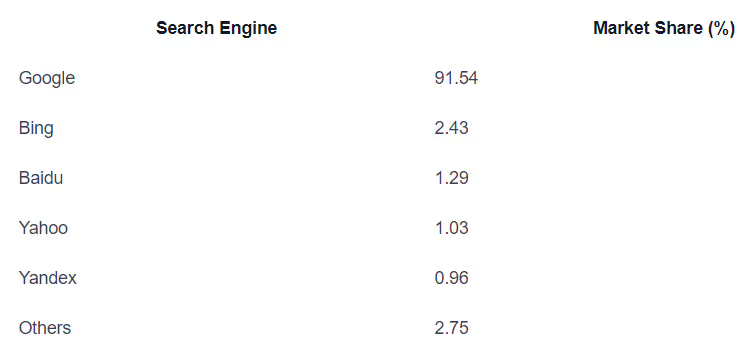Insights into Google Search Engine Usage Statistics
To understand the usage statistics of Google as a search engine, it is important to explore the overall search engine market and the market share held by various search engines.


Insights into Google Search Engine Usage Statistics
Google Search Engine Market Share
To understand the usage statistics of Google as a search engine, it is important to explore the overall search engine market and the market share held by various search engines.
Overview of Search Engine Market
The search engine market is highly competitive, with several players vying for users' attention. However, Google stands out as the leader in this space. As of June 2023, Google's market share was an impressive 90.68%, making it the most popular and most used search engine in the world [1]. Google's dominance in the search engine market is a testament to its reliability, relevance, and vast array of features that cater to users' search needs.
Market Share by Search Engine
When it comes to market share, Google's dominance is evident. It owns just over 92% of the global search engine market, including 72% of the desktop market and a staggering 92% of the mobile search engine market. Bing holds a distant second place with a 2.9% market share, while Yahoo accounts for 1.1%. These numbers highlight Google's overwhelming presence and its position as the go-to search engine for millions of users worldwide.
To further emphasize Google's market share, let's take a look at the global market share of leading desktop search engines from January 2015 to January 2024. Throughout this period, Google maintained its dominance, consistently holding the largest market share [3].

Figures courtesy of StatCounter Global Stats, 2023
These numbers clearly demonstrate Google's dominance, with a market share of 91.54% globally. This includes a market share of 82.74% in the desktop search engine market and an even more impressive 95.16% in the mobile search engine market [4]. Google's popularity and widespread usage make it the default choice for the majority of users when it comes to searching for information online.
In conclusion, Google's search engine market share is a testament to its position as the global leader in search. Its widespread usage and dominance across both desktop and mobile platforms make it the preferred choice for users worldwide. As we explore further into Google's impact, algorithm updates, and search trends, we will gain a deeper understanding of its influence on web traffic and user behavior.
Google's Dominance in Search
When it comes to search engines, Google stands tall as the clear frontrunner, dominating the market with its global reach and user-friendly interface. Let's explore some statistics that highlight Google's unparalleled dominance in the search engine space.
Google's Global Market Share
Google's market share is a staggering 90.68% as of June 2023, making it the most popular and most used search engine in the world [1]. It owns just over 92% of the global search engine market, including 72% of the desktop market and a whopping 92% of the mobile search engine market. In comparison, Bing holds a mere 2.9% of market share, while Yahoo accounts for 1.1% [2].
The dominance of Google in the search engine market is further evident when we consider the global market share of leading desktop search engines. From January 2015 to January 2024, Google consistently held the majority of the market share, solidifying its position as the go-to search engine for users worldwide.
Google Search Queries Statistics
Google's overwhelming popularity is also reflected in the number of search queries it handles. As of February 2024, Google accounted for a remarkable 91.62% of all search queries conducted across all search engine providers worldwide. This means that more than nine out of 10 internet users prefer Google when searching for information online.
To put it into perspective, Google accounts for 91.54% of the global search engine market, with 82.74% of the desktop search engine market and an impressive 95.16% market share on mobile devices. These statistics clearly illustrate the unparalleled dominance of Google in the search engine landscape.
With its vast user base and continuous innovation, Google remains the search engine of choice for billions of people around the world. Its market share and search query statistics highlight its position as the undisputed leader in the search engine market.
Impact of Google Algorithm Updates
Google's algorithm updates have a significant impact on web traffic and search engine rankings. These updates, designed to improve the quality and relevance of search results, can have both positive and negative effects on websites' visibility and organic traffic.
Influence on Web Traffic
According to a survey conducted by HubSpot, 65% of SEOs report that Google's algorithm updates have had a positive impact on their web traffic and search engine results page (SERP) rankings. These updates aim to deliver more accurate and useful information to users, which can lead to increased visibility and organic traffic for websites that adhere to Google's guidelines.
However, it's important to note that algorithm updates can also have negative consequences for websites that do not comply with Google's standards. Websites that engage in manipulative or spammy tactics may experience a drop in rankings and a decrease in organic traffic.
To stay ahead of algorithm updates, website owners and SEO professionals should regularly monitor industry news and keep up with Google's guidelines. By focusing on providing high-quality, relevant content and following best SEO practices, websites can mitigate the potential negative impact of algorithm updates and maintain or improve their web traffic.
AI Search and User Behavior
Google's advancements in artificial intelligence (AI) have revolutionized the way search engines understand and interpret user queries. The integration of AI technologies, such as natural language processing and machine learning, has allowed Google to provide more personalized and contextually relevant search results.
As per the survey by HubSpot, 70% of web analysts and SEOs believe that the new AI search capabilities will incentivize people to use search engines more frequently than before [2]. AI-powered search algorithms can better understand user intent, deliver more accurate results, and adapt to evolving user behavior.
Google's AI algorithms take into account various factors, including user preferences, search history, location, and device, to provide customized search results. By understanding user behavior patterns and preferences, Google can improve the overall search experience and increase user satisfaction.
Website owners and SEO professionals should consider these AI advancements when optimizing their websites for search engines. By understanding how AI influences search results and user behavior, they can align their SEO strategies to provide the most relevant and valuable content to their target audience.
Understanding the impact of Google algorithm updates and the integration of AI in search helps website owners and SEO professionals adapt their strategies to stay competitive in the ever-evolving search landscape. By keeping up with industry trends and optimizing their websites accordingly, they can harness the potential of Google's search engine and drive organic traffic to their sites.
Google's Search Index and Crawlers
Google's search index and its web crawlers play a vital role in providing accurate and up-to-date search results. Understanding the size of the search index and the functioning of web crawlers can shed light on the sheer magnitude of Google's search capabilities.
Search Index Size
Google's search index is an immense database that contains a vast amount of information from web pages across the internet. While specific figures may vary, it is estimated that Google's search index is over 100,000,000 GB in size, representing an extensive collection of web pages, documents, images, and other online content. This colossal index allows Google to quickly retrieve relevant search results for users.
Web Crawlers and Data Updates
To build and maintain its search index, Google employs web crawlers, also known as spiders or bots. These automated programs systematically traverse the internet, visiting and analyzing web pages to gather information. The web crawlers follow hyperlinks from one page to another, continuously discovering and indexing new content.
Google's web crawlers not only index web pages but also revisit previously indexed pages to ensure that the search index remains up to date. When a web page undergoes changes or updates, the web crawlers revisit it to capture any modifications and reflect them in Google's search results.
By constantly crawling and updating its search index, Google strives to provide users with the most relevant and current information available on the internet. The frequency of crawling can vary depending on factors such as the popularity and importance of a web page. More frequently updated pages, such as news websites, may be crawled more often to capture the latest information.
It is important to note that while the search index and web crawlers are essential for Google's search engine, the specific algorithms and processes employed by Google are proprietary and closely guarded. Therefore, the exact workings of Google's search index and web crawlers are not disclosed publicly.
Understanding the vast size of Google's search index and the continuous work of web crawlers provides insight into the complexity and scale of the search engine. This infrastructure allows Google to deliver relevant search results to users across the globe, making it the dominant force in the search engine market.
Mobile Search Trends
In today's digital landscape, mobile devices have become an integral part of our lives, and this is reflected in the way we search for information. Mobile search usage has experienced significant growth in recent years, and Google has embraced this trend with its mobile-first indexing approach.
Mobile Search Usage
According to Statista, 63% of searches in the U.S. occur on mobile devices. This highlights the importance of optimizing websites and content for mobile users. With the increasing prevalence of smartphones and tablets, people are turning to their mobile devices to find answers, shop, and explore the web.
Mobile-First Indexing
Google recognized the shift towards mobile search and introduced mobile-first indexing. This approach prioritizes the mobile version of a website's content for indexing and ranking. Mobile-first indexing means that Google predominantly uses the mobile version of a website's content to determine its relevance and rank it in search results.
As of StatCounter Global Stats, Google holds 91.54% of the global search engine market share, with a staggering 95.16% market share on mobile. This highlights Google's dominance in the mobile search landscape, solidifying its position as the go-to search engine for mobile users.
With mobile-first indexing, it's crucial for website owners and developers to ensure their websites are mobile-friendly and responsive. This involves optimizing the design, layout, and functionality of the website to provide a seamless user experience across various mobile devices.
By embracing mobile search trends and optimizing for mobile-first indexing, businesses and website owners can effectively reach and engage with their target audience. It's important to stay up to date with the latest mobile optimization practices and monitor the performance of your website on mobile devices to ensure maximum visibility and user satisfaction.
In conclusion, mobile search usage continues to grow, and Google's mobile-first indexing approach reflects this trend. As more people rely on their mobile devices for search, it becomes imperative for businesses and website owners to prioritize mobile optimization to enhance their online presence and cater to the needs of mobile users.
Google Trends Insights
Google Trends is a powerful tool that provides valuable insights into search engine usage statistics. It offers real-time data access and allows users to analyze search trends, patterns, and interests across various topics. In this section, we will explore two important aspects of Google Trends: real-time data access and data normalization and filtering.
Real-Time Data Access
Google Trends provides access to real-time data, allowing users to explore search trends within the last seven days. This real-time data can be valuable for tracking the latest trends and staying up to date with current search interests. By analyzing real-time data, marketers and businesses can gain insights into emerging topics and adjust their strategies accordingly.
It's important to note that the real-time data available on Google Trends is subject to a delay of up to 72 hours before the search. This delay allows Google to process and organize the vast amount of data generated by search queries. Nonetheless, even with this slight delay, Google Trends offers a near real-time snapshot of search trends and user interests.
Data Normalization and Filtering
To make search data more meaningful and comparable, Google Trends employs data normalization and filtering techniques. Data normalization is the process of dividing each data point by the total searches of the geography and time range it represents. This normalization allows for easier comparisons between different search terms, regardless of the variations in search volume.
Additionally, Google Trends filters out certain searches to ensure the accuracy and relevance of the data. These filters remove searches made by very few individuals, duplicate searches, and searches with special characters. The filtered data provides a clearer representation of search interest and avoids skewing the results with irrelevant or insignificant queries.
It's important to understand that while Google Trends provides valuable insights, it is not a scientific poll. The data should be interpreted as one point among others when drawing conclusions. Users should consider the limitations of the data and use additional research methods to supplement their analysis.
Compared to the AdWords search terms report, which is more geared towards advertisers, Google Trends offers more granular real-time data. While the AdWords search terms report focuses on monthly and average search volumes, Google Trends provides a deeper dive into real-time search trends, allowing users to identify emerging patterns and interests.
By leveraging the power of Google Trends, businesses, marketers, and researchers can gain valuable insights into search engine usage statistics and make informed decisions based on real-time data. Whether it's tracking the popularity of certain topics, monitoring the effectiveness of marketing campaigns, or understanding user behavior, Google Trends provides a wealth of information to guide strategic decision-making.
References
[1]: https://www.similarweb.com/engines/
[2]: https://blog.hubspot.com/marketing/google-search-statistics
[3]: https://www.statista.com/statistics/216573/worldwide-market-share-of-search-engines/
[4]: https://www.semrush.com/blog/google-search-statistics/
[5]: https://www.oberlo.com/statistics/search-engine-market-share







